Features
As Oxford’s new academic year gets underway, we take a closer look at an award-winning teaching module that brings students face-to-face with real-world high-stakes decisions.
What would you do if there was a sudden nuclear threat from North Korea and you were responsible for deciding how your country responded? At Oxford University’s Blavatnik School of Government, Master of Public Policy (MPP) students tackle this challenge head-on in the 'North Korea Crisis Simulation' – an immersive teaching module that represents an innovative approach to teaching public policy.
The one-year postgraduate degree is designed to equip future leaders with practical skills for public policy practice. Its students come from around the world – last year hailing from 58 different countries and diverse backgrounds such as government, NGOs, journalism and academia.
The simulation, which was recognised earlier this year by the Vice-Chancellor’s ‘Innovative Teaching and Assessment’ Award, plunges the MPP students into a complex economic, political, and military crisis on the Korean peninsula; testing their ability to make high-stakes decisions, balance national priorities, manage security concerns, and collaborate with international partners under extreme pressure – all within a world marked by interconnected crises and rising geopolitical competition.
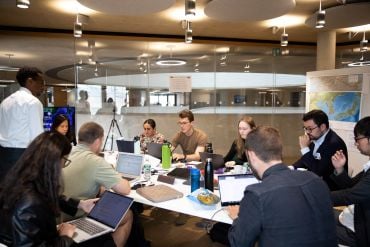 Students assigned to the DPRK (North Korea) room developing strategy
Students assigned to the DPRK (North Korea) room developing strategyThe simulation is the brainchild of Professor Tom Simpson, who has first-hand experience of complex military situations, having served as an officer with the Royal Marine Commandos for five years. It incorporates elements of a ‘war game’, imitating a geopolitical crisis scenario where participants’ actions impact the options available to others.
This simulation challenges students to integrate theoretical knowledge with practical skills, pushing them to perform under high-stakes conditions.
It provides a deeply immersive experience that evolves based on their decisions, enhancing their understanding of national power dynamics. So our students are gaining invaluable insights into real-world policymaking and developing skills directly applicable to their future careers.
Professor Tom Simpson, Blavatnik School of Government
Split into six teams or countries – USA, China, Japan, Russia, South Korea, and North Korea – the students operate from meticulously designed ‘situation rooms’ complete with national flags, authentic snacks, and tailored props such as national seals on stationery, badges, and door plaques, as well as portraits of national leaders. The rooms are equipped with a bespoke communications suite, giving students the ability to receive recordings and live broadcasts from the dedicated Green Room.
In the weeks leading up to the simulation, MPP students receive detailed background briefings and in-depth reading assignments and research into the history of the crisis, the political, economic, and cultural characteristics of the countries in the region, and the national interests of the six countries involved. But it’s not until 24 hours before the exercise itself begins, when they are presented with confidential instructions, that they learn what their individual roles in the simulation will be. And then, at the start of the simulation, they finally learn about the crisis that is unfolding.
Aoife, a student from Northern Ireland who was assigned the role of the Chief of Staff to the President of the USA said: ‘I got to be a decision-maker at the epicentre of the simulation, which taught me a lot about teamwork, how to handle pressure, and the importance of maintaining focus on your ultimate goal.’
She also reflected on the challenges of working collaboratively in such a pressured environment: ‘It was really eye-opening to be thrown into a scenario where you have only limited information, there’s mistrust across teams, but the stakes are so high that you know you have to find a way of working together.’
 Students participating in the breaking news broadcast that concludes the simulation
Students participating in the breaking news broadcast that concludes the simulationWhile fictional, events in the simulation closely resemble real-world occurrences, such as the abduction of Japanese citizens by North Korea, financial turbulence, and gunfire in the Demilitarised Zone, to emphasise the complexities of real-world decision-making.
Erik, a Ukrainian MPP student, reflected: ‘The most valuable lessons were about teamwork under immense time pressure and responsibility; organising team efforts, balancing each member's involvement with the need to make quick decisions, effectively delegating tasks, and strategic action planning. I learned the importance of being ready to pursue moderate goals, as aiming for maximalist objectives can lead to counterproductive results.’
The award-winning ‘North Korea Crisis Simulation’ is one example of an immersive teaching method that has long been championed by the Blavatnik School’s Case Centre on Public Leadership, which develops teaching materials for public leaders at all career stages, thrusting them into the heart of a range of crises and challenges around the globe. The North Korea Crisis Simulation module has been made freely available for other schools of public policy to download here.
Batteries will play a fundamental role in our journey to Net Zero, but current markets lack the technological and policy infrastructure to ensure batteries are optimally used throughout their full life cycle, including in ‘second life’ applications. The Oxford Martin School Programme on Circular Battery Economies aims to deliver a blueprint for a truly circular battery economy, with a focus on leveraging opportunities in the Global South.
The programme is led by Paul Shearing, Professor of Sustainable Energy Engineering at the Department of Engineering Science and Director of the ZERO Institute. Here, he introduces the programme’s ambitious aims, the opportunities to address multiple challenges across the energy sector, and why Oxford is a natural hub for such crossdisciplinary work.
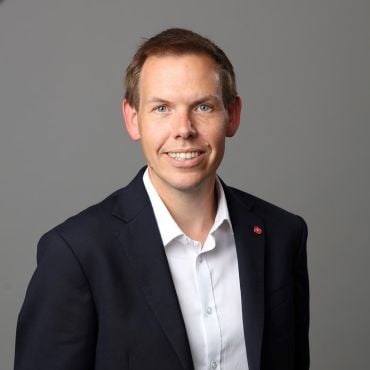 Professor Paul Shearing.
Professor Paul Shearing.
Transitioning to electric transport is crucial to achieve global Net Zero goals, and this movement is accelerating rapidly. But what hasn’t happened so quickly is the development of markets and infrastructure to ensure that these batteries are optimally used throughout their lifetime, including at the end of ‘first-life’ service in a vehicle.
Typically, electric vehicle (EV) batteries retain 70-80% of their initial capacity when they reach the end of their useful life in the vehicle. This means they have considerable potential for ‘second life’ purposes, such as for storage for intermittent renewable energy sources including wind and solar. Unfortunately, such ‘second-life’ purposes are currently seldom realised. Because people use their cars in very different ways, there is immense variability in the state of EV batteries once they reach the end of their first life. This leads to uncertainty over the safety and performance of used batteries, limiting their reuse. Since battery recycling remains immature, disposal of EV batteries is fuelling a waste management crisis and loss of critical materials.
Meanwhile, around 760 million people lack access to electricity, mostly living in sub-Saharan Africa and South Asia. Energy storage assets will be crucial to enable these communities to establish zero carbon energy systems. The idea of redeploying used EV batteries as energy storage solutions in emerging economies is highly attractive, since this could deliver three key aims: maximising the economic value of batteries, offsetting the embedded carbon emissions of batteries through maximal use, and supporting the energy transition in developing regions.
Our vision is to support widespread adoption of electrified transportation globally, enable a sustainable circular battery economy, and promote equitable access to clean energy solutions that benefit society.
Professor Paul Shearing
What are the main objectives for the programme?
In summary, our bold vision is to develop a theoretical blueprint for a safe and equitable ‘second-life’ battery industry. Our initial focus will be on India and Africa, where we already have strong established partnerships. We will anchor our work around three integrated multidisciplinary pillars, which will each be developed in deep consultation with stakeholders.
The first focus is to better understand the potential value of a battery circular economy between the Global North and South. This will include mapping global battery flows, quantifying environmental impacts, and evaluating techno-economic cases for battery reuse and repurposing.
Second, we will develop robust tools for battery recertification. Our aim is to establish rapid, cost-effective tests and screening tools to evaluate the state of health and the remaining useful life of EV batteries. Working with stakeholders, we will ensure that these can be easily adopted by end-users.
Third, we will investigate how policy, institutional, and regulatory landscapes influence the uptake of second-life batteries in emerging economies, and how battery usage relates to wider energy transition goals.
Professor Paul Shearing and Dr Anupama Sen introduce the Oxford Martin Programme on Circular Battery Economies
Developing a circular electric vehicle battery economy mandates a multidisciplinary approach, balancing technical and social sciences, to ensure that proposed interventions are technically viable, sensitive, and people-centric.
Professor Paul Shearing
Who are you collaborating with?
The project has six academic leads. Within the Department of Engineering Science, there is myself, Professor David Howey, Professor Charles Monroe, and Associate Professor Thomas Morstyn. Between us, we have expertise across electrochemical engineering, battery materials development, systems engineering for energy storage systems, battery cell modelling, grid storage modelling, and energy market design.
From the Smith School for Enterprise and Environment, Associate Professor Radhika Khosla and Dr Anupama Sen bring policy expertise (particularly in energy consumption trajectories), urban transitions, and climate change governance in the context of development. Radhika’s position as leader of the Oxford India Centre for Sustainable Development (OICSD) at Somerville College also enables us to leverage a breadth of established contacts throughout India to reach key stakeholders.
Why is Oxford best-placed to lead on this?
We are very proud that Oxford is the birthplace of the lithium-ion battery, thanks to Professor John Goodenough’s work in the 1970s and 80s. Ever since, Oxford has been a global leader in lithium-ion battery research and has developed multidisciplinary strengths in this area.
Additionally, in Oxford- and particularly the Oxford Martin School – there is a real drive to co-develop technological solutions with stakeholders, and road-test these to ensure they are economically viable for communities. This requires integrating many different areas of expertise and Oxford is a wonderful and creative hub for that kind of work. There are not many places where you will find the concentration of expertise to enable such cross-cutting work. This is far more than, say, a chemical engineer working with a mechanical engineer, but a fully interdisciplinary approach across the entire collegiate university.
There is uncertainty over the safety and performance of used batteries, limiting their reuse. Since battery recycling remains immature, disposal of EV batteries is fuelling a waste management crisis and loss of critical materials.
Professor Paul Shearing
How will the programme help build future capacity, for instance in training new researchers?
The project will recruit several postdoctoral researchers, who will develop a highly transdisciplinary skillset across engineering and physical sciences, economics, modelling, and social sciences. This will equip them to be the future leaders that we need for holistic, just, equitable transitions to Net Zero based on sound technology. It really taps into James Martin’s belief that we need people with wide skillsets and the ability to think in broader contexts to be effective in tackling the big questions confronting us.
More widely, a philosophy of engagement and dissemination is woven throughout the programme. In particular, we aim to disseminate the findings from India and Kenya to empower communities across the Global South to co-create solutions to adopt electric transport and manage critical materials. This will use the extensive contacts we already have built up, particularly through our involvement with the URKI Ayrton Challenge for Energy Storage, where Professor Howey is a member of the strategic leadership group, and the Faraday Institution’s Battery Ambassadors program, which connects us with a network of researchers across 13 countries.
What excites you most about this new work?
As a concept, second life redeployment of EV batteries has been widely discussed for over two decades, but very little practical progress has been made so far. If we can get this right, it can serve as an exemplar for how we can rethink future energy systems to truly embed sustainability and circular economy principles. There will also be much broader lessons for any industry relying on limited critical materials.
When I started my research career, the focus was on developing cheaper batteries with higher energy densities. Now the zeitgeist has moved towards optimising sustainability and circularity. It excites me to be part of a project that will play a major role in setting the discourse of battery research for the next ten years.
Alison Farrar, a DPhil student researching how bacteria respond to antibiotic treatment at the Oxford Martin School, explains how citizen science and artificial intelligence are helping to combat the growing threat of antibiotic resistant bacteria.
Antibiotic resistance poses one of the most urgent challenges to public health worldwide. In this process, bacteria acquire genetic mutations that help them to become resistant to antibiotics. If bacteria become completely resistant to all antibiotics, this treatment will effectively become useless, and simple infections could cause deaths. In fact, this problem is already causing an estimated 1.3 million deaths every year.
One of the biggest challenges is that current testing methods can take up to two days to determine the most effective antibiotic for an infection. The goal of the Oxford Martin Programme on Antimicrobial Resistance Testing was to create a test that detects whether a patient’s bacteria are resistant to antibiotics within an hour. The test works by taking images of a patient’s bacteria under a microscope and using artificial intelligence (AI) to look for any changes that occur when antibiotics are applied to these samples. We recently published results from our citizen science project that investigated what makes some of these bacteria harder for AI to classify.
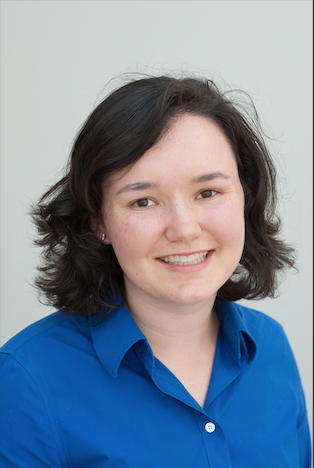 Alison Farrar
Alison FarrarImage credit: Oxford Martin School
We collected thousands of images of resistant and sensitive bacteria treated with antibiotics. Bacteria that are sensitive to an antibiotic treatment develop changes to their shape, DNA, and cell wall. The AI model learns to detect these changes by studying images of bacteria that have responded to the antibiotic treatment and images of bacteria that don’t.
Sometimes, even though our AI model has seen thousands of images of antibiotic-treated bacteria, it still makes mistakes. In a recent research paper we showed that our current model is about 80% accurate at classifying each Escherichia coli (E. coli) cell. Although this leads to very high confidence when determining whether a whole sample is antibiotic sensitive or resistant, we want our diagnostic test to be as robust as possible.
We noticed that there was some variation in the extent to which E. coli cells changed after the antibiotic treatment, even when they were treated with the same concentration of antibiotic and had the same level of antibiotic resistance. In some cases, cells that looked like a resistant cell were actually sensitive, and vice versa. We started the Infection Inspection project to see which bacterial cells were most likely to be misinterpreted by volunteers, so that we could learn what features might also confuse the AI model. Then, we could focus on understanding those types of cells in our future research. We were also curious whether humans could detect more nuanced features than the AI model.
Volunteers were shown a picture of an E. coli cell that we treated with the antibiotic ciprofloxacin, stained, and imaged with our microscope. Because we grew the E. coli from strains collected at the hospital microbiology laboratory, we knew which strains were sensitive or resistant to ciprofloxacin on standard tests. Equipped with the field guide, volunteers could classify each image as resistant, sensitive, or an image processing error.
We were honoured that more than 5,000 volunteers contributed more than 1 million classifications to our project.

How difficult is it to classify a bacterial cell?
To understand which images were most likely to be misclassified as resistant or sensitive, we needed a way to measure whether a volunteer’s classification matched what we expected. We used E. coli cells from 5 clinical strains with different levels of resistance and treated them with different concentrations of ciprofloxacin for 30 minutes. We decided that if a cell was treated with an antibiotic concentration greater than its level of resistance, we expected it to look ‘sensitive’. In contrast, if a cell was treated with an antibiotic concentration less than its level of resistance, we’d expect it to look ‘resistant’. By defining these categories, we could discover when the biology didn’t match these predictions.
As we suspected, there was a lot of variety in how easy a cell was to classify and how well it lined up with our predictions. Some cells were classified correctly every single time, others most of the time, and others almost never. This was true for both ‘resistant’ and ‘sensitive’ cells. We could tell from images of cells that were rarely classified correctly that they had unusual or atypical DNA features.
From our analysis of the volunteer classifications, we couldn’t find any relationship between a volunteer’s accuracy and the number of images they classified or the number of days they were active on the project. It seemed like most of the difficulty of this task comes from the images themselves, rather than a user’s expertise.

What we learned and what comes next
The Infection Inspection project showed us that misclassifications of ciprofloxacin-sensitive and ciprofloxacin-resistant E. coli bacteria are associated with greater diversity in the appearance of the bacterial DNA after antibiotic treatment. It seems like most misclassifications happen when the features don’t line up with what we expect from a ‘sensitive’ or ‘resistant’ cell, rather than our AI misidentifying features.
Even though we expect the bacteria in each of our samples to be genetically identical, there are clearly some cells that respond differently than others. This is an area with lots of open questions that we are designing experiments to answer.
Some volunteers started to notice that in some of our images, it looked like a cell was in the process of cell reproduction. This idea could be related to why some of the bacteria in our samples respond differently than others. It’s possible that the stage of the bacterial life cycle at which the cell is exposed to the antibiotic has an impact on the appearance of the DNA. This is a question we’ll continue to explore in our research.
Thank you
Our group is actively looking into the antibiotic response of many bacterial species to different antibiotics, so that we can develop a rapid test for antibiotic resistance. There is a lot to learn here, and we are extremely grateful to the Zooniverse volunteers who participated. Their enthusiasm and curiosity were extraordinary, so thank you for your dedication and engagement. We’d also like to thank the Zooniverse platform leaders, Helen Spiers, Mary Westwood, and Cliff Johnson, for their expertise and contributions to the development of this project.
Antimicrobial resistance (AMR) is one the most pressing challenges facing the world today. Common infections that were once easily treated by antibiotics are becoming life-threatening again. By 2050 it is predicted that over 10 million deaths will be caused by drug-resistant infections every year.
At the Ineos Oxford Institute for antimicrobial research (IOI), created in 2021 to advance antimicrobial research, Oxford’s graduate students are among those contributing to the search for solutions to tackle this growing threat to global health.
34 DPhil students from around the world are based at the IOI, each part of a focused research project that works to develop new antibiotics or study the spread and impact of AMR around the world.
 IOI DPhil student Kate Cook with research assistants Maryam and Firdausi in Kano, Nigeria
IOI DPhil student Kate Cook with research assistants Maryam and Firdausi in Kano, NigeriaWorking closely with two research assistants in the hospital – Maryam and Firdausi – Kate acts as a microbiological detective, identifying which kinds of bacteria are causing infections in patients, then investigating whether these bacteria are also present on hospital surfaces, and in insects caught on the wards.
“Designing creative experiments is the best part of my work. It can be challenging when there are huge numbers of samples to analyse, and trying to figure out how the bacterial transmission networks fit together, but the project is very rewarding. The opportunity to work with the team in Kano, who are equally as passionate about the project has been amazing.”
 IOI DPhil student Shonnette Premchand-Branker preparing plates in the lab
IOI DPhil student Shonnette Premchand-Branker preparing plates in the labA microbiologist by training, Shonnette analyses fly samples which will be collected from countries across the globe.
“The flies are sent to our lab in Oxford after they have been collected and labelled in hospitals. They arrive whole, so our first step is to homogenise them, which basically means we make fly juice. The next step is to prepare bacterial cultures, and then extract and sequence their DNA. We’re looking for antimicrobial resistance genes that we know are related to multidrug-resistant infections.”
 IOI DPhil student Chy Akpulu preparing samples for analysis in the lab at IOI
IOI DPhil student Chy Akpulu preparing samples for analysis in the lab at IOIThe work is potentially life-saving – antibiotic resistance to sepsis is a leading cause of deaths in newborns, with 99% of global newborn mortality occurring in low-and-middle income countries.
“I am drawn to research that directly benefits people, and the work that the BARNARDS team were doing really resonated with me - not just scientific enquiry but helping the community itself by translating research into better clinical outcomes.”
 IOI DPhil student Wojtek Treyde at his desk at IOI
IOI DPhil student Wojtek Treyde at his desk at IOI
Wojtek Treyde, a PhD student who has previously studied at the University of Heidelberg in Germany is part of the INEOS Oxbridge Doctoral Initiative on Antimicrobial Resistance – a fully funded DPhil programme that enables up to seven candidates to study at both the universities of Oxford and Cambridge.
Wojtek is a computational chemist working on drug development. His PhD project combines his research experience so far – an undergraduate degree in chemistry and master’s degree with a focus in Machine Learning.
A branch of chemistry, computational chemistry uses computer simulations to solve complex chemical challenges, such as the discovery of new antibiotics to tackle rising rates of AMR. Wojtek works closely with lab-based researchers at the IOI to use machine learning to inform research.
“I wanted to use my training in an area where I could make a difference. Alongside climate change, AMR is the biggest threat facing humanity and I want to contribute to finding new solutions.”
 Professor Mark Graham
Professor Mark GrahamWithout data annotators creating datasets that can teach AI the difference between a traffic light and a street sign, autonomous vehicles would not be allowed on our roads. And without workers training machine learning algorithms, we would not have AI tools such as ChatGPT.
Professor Mark Graham researches global technology through the eyes of the hidden human workforce who produce it. He argues that AI is an "extraction machine", churning through ever-larger datasets and feeding off humanity’s labour and collective intelligence to power its algorithms.
We caught up with Mark to discuss some of these issues.
In talking about the AI technologies we rely on, you mention the "countless humans forced to work like robots, toiling in monotonous low-paid jobs just to make such remarkable machines possible" -- who are these people, and what sorts of jobs are they doing?
There is a whole range of ‘data work’ needed to make our digital lives possible. Data annotators label data with tags so that it can be understood by computer programs. Content moderators sift through digital content in order to remove harmful content that breaches company guidelines. If you have ever interacted with any form of AI, whether it be a chatbot, a search engine, a social media feed, a streaming recommendation system, or a facial recognition system, data workers have had a hand in building or maintaining those systems.
The root cause of the problems encountered by data workers lies in the power imbalance between them and the institutions that govern their jobs… It is unlikely that any of the issues data workers experience will ever be meaningfully addressed without workers building their collective power in movements and institutions.
You talk about "building worker power", as a step towards redressing some of the issues of the hidden labour of AI — I guess this is quite difficult when these jobs are so atomised, and the workforce so expendable?
The root cause of the problems encountered by data workers lies in the power imbalance between them and the institutions that govern their jobs. Historically, when social movements achieve lasting change, it's often through organizing a critical mass of people to push for policies that address systemic inequalities. It is therefore unlikely that any of the issues data workers experience will ever be meaningfully addressed without workers building their collective power in movements and institutions.
However, data workers face serious barriers to ever building that power. The jobs that they undertake are relatively footloose and standardised, and, as a result, are carried out in a planetary-scale labour market. Their jobs can be quickly shifted to the other side of the planet.
There are no easy ways for workers to build collective power under these sorts of conditions. Data workers in a country like Kenya or the Philippines have an enormous structural disadvantage. However, that is not to say that organizing is impossible. In production networks that are organised globally, workers will increasingly also need to explore ways of organising across geographies. This will undoubtedly take a range of forms, but will all need to be rooted in the principle that workers acting collectively will be able to demand better conditions for everyone in a production network. Isolated efforts, by contrast, are unlikely to achieve lasting change.
A requirement of accountability is visibility. What are some of the ways that this labour is hidden from us -- and why? How could it be made more open and visible, more recognised?
The labour in AI production networks is almost always hidden from view. If you drink a cup of coffee or buy a pair of shoes, you probably have a conception that at some point that coffee passed through the hands of a plantation worker or the shoes were assembled by someone in a sweatshop. However, precisely because AI presents itself as automated, very few people can imagine what the human labour on the other side of the screen looks like. AI companies are complicit in this subterfuge. They want to present themselves as technological innovators rather than as the firms behind vast digital sweatshops.
Because AI presents itself as automated, very few people can imagine what the human labour on the other side of the screen looks like. AI companies are complicit in this subterfuge.
Because of this enormous gap between how tech companies present themselves and the actual on-the-ground conditions experienced by workers in those production networks, I started the Fairwork project. Fairwork evaluates companies against principles of decent work and gives every company a score out of 10 based on how well they stack up against those principles. To date, we have scored almost 700 companies in 38 countries. Doing this work has encouraged a lot of companies to make improvements to the working conditions of their workers to receive a higher score.
The next phase of our project will involve going to the lead firms in AI production networks, the brands that consumers are familiar with, and letting them know that we are going to start holding them accountable for all the working conditions upstream in their production networks. We will constructively work with them to embed principles of fair work into their contracts and supplier agreements, but also use our research to hold them accountable when they fail to do so.
Watch Mark’s latest video highlighting the hidden cost of AI and the implications of this ever-evolving technology for the thousands of AI workers toiling away behind the scenes to deliver AI powered services.
I guess an obvious solution to some of these issues is regulation -- workers should be protected in whatever jurisdiction they are working, and wherever in the production chain they sit. What efforts are being made in this area?
The planetary labour market that much of this work is traded in makes it difficult for regulators in the Global South to raise conditions. If regulation raises costs in Kenya, those jobs can move to India. If regulation in India raises costs, those jobs can move to the Philippines. These dynamics create a ‘race to the bottom’ in wages and working conditions, leaving regulators having to choose between bad jobs or no jobs. As the economist Joan Robinson famously said, ‘The misery of being exploited by capitalists is nothing compared to the misery of not being exploited at all.'
However, even though the global geography of the labour market neuters the ability of regulators to act in the Global South, it strengthens the hand of regulators in the Global North. Regulators in countries that are home to a lot of the demand for digital products and services have the ability to play an outsized role in setting standards. The EU's proposed Supply Chain Directive is a good example of this. It aims to make companies operating in the EU accountable for human rights and environmental impacts throughout their global supply chains. Because few AI companies will want to forgo being able to sell to consumers in the EU, this directive has the potential to improve conditions for the many workers in countries with weak labour protections.
Much of the discussion about AI has been focused on existential risks that it might present in the medium- to long-term future. However, the real risks of AI are already right here in the present.
Finally, your assessment of the AI industry is pretty bleak, that "workers are treated as little more than the fuel needed to keep the machine running" — and that this is happening to all of us, right now. What are some of the key issues and battlegrounds in which this question will be played out in the coming years?
Much of the discussion about AI has been focused on existential risks that it might present in the medium- to long-term future. However, the real risks of AI are already right here in the present.
A few decades ago, anti-sweatshop campaigns shifted attention to the plight of garment workers, and shifted the onus of responsibility for those workers onto the brands who sell clothes. Those campaigns did not fully eradicate sweatshops, but have been an important moment on a path to normalising the idea that lead firms in production networks have the potential power to impose decent work conditions throughout a supply chain. If we are to head towards a fairer future of work, one of the key battlegrounds will have to be ensuring that big tech companies take responsibility for the conditions of all workers in their supply chains.
Because tech companies have, to date, taken on very little of this responsibility, pressure will be required from consumers, policy makers, and workers. Consumers will have to recognise that they are complicit in the conditions of workers who made or maintained the product or service that they are using. Policy makers will have to realise that a laissez-faire approach to regulation is only serving to increase inequalities. And workers will have to find ever more creative ways to organise across supply chains in order to hold companies accountable. Until we all force these companies to change, we will only continue to be nothing more than fuel for the machine.
***
Professor Mark Graham was talking to the OII's Scientific Writer, David Sutcliffe.
Mark Graham is Professor of Internet Geography at the Oxford Internet Institute, where he leads a range of research projects spanning topics between digital labour, the gig economy, internet geographies, and ICTs and development. He's also the Prinicipal Investigator of the participatory action research project Fairwork, which aims to set minimum fair work standards for the gig economy.
Read his latest book: James Muldoon, Mark Graham, and Callum Cant (2024) Feeding the Machine. Canongate.
- 1 of 248
- next ›


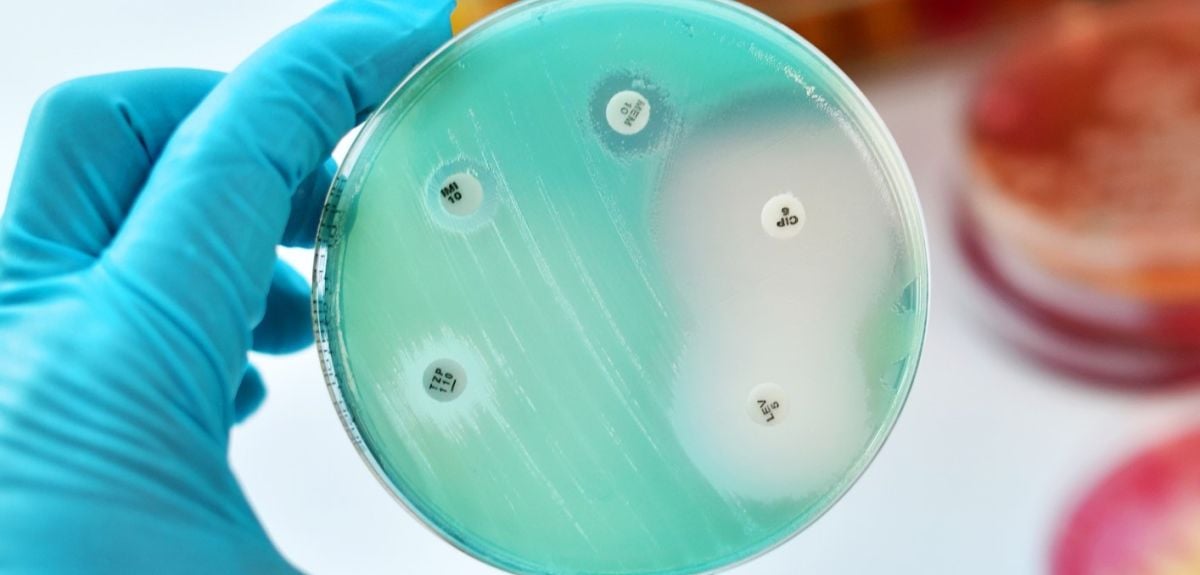


 Teaching the World’s Future Leaders
Teaching the World’s Future Leaders  A blueprint for sustainability: Building new circular battery economies to power the future
A blueprint for sustainability: Building new circular battery economies to power the future Oxford citizen science project helps improve detection of antibiotic resistance
Oxford citizen science project helps improve detection of antibiotic resistance The Oxford students at the forefront of the fight against microbial resistance
The Oxford students at the forefront of the fight against microbial resistance  The hidden cost of AI: In conversation with Professor Mark Graham
The hidden cost of AI: In conversation with Professor Mark Graham  Astrophoria Foundation Year: Dr Jo Begbie reflects on the programme’s first year
Astrophoria Foundation Year: Dr Jo Begbie reflects on the programme’s first year World Malaria Day 2024: an interview with Professor Philippe Guerin
World Malaria Day 2024: an interview with Professor Philippe Guerin From health policies to clinical practice, research on mental and brain health influences many areas of public life
From health policies to clinical practice, research on mental and brain health influences many areas of public life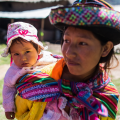 From research to action: How the Young Lives project is helping to protect girls from child marriage
From research to action: How the Young Lives project is helping to protect girls from child marriage